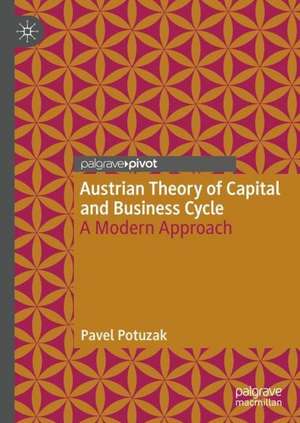Austrian Theory of Capital and Business Cycle: A Modern Approach
Autor Pavel Potuzaken Limba Engleză Hardback – 13 dec 2022
Preț: 319.04 lei
Nou
Puncte Express: 479
Preț estimativ în valută:
61.05€ • 65.28$ • 50.90£
61.05€ • 65.28$ • 50.90£
Carte tipărită la comandă
Livrare economică 18 aprilie-02 mai
Preluare comenzi: 021 569.72.76
Specificații
ISBN-13: 9783031187278
ISBN-10: 303118727X
Ilustrații: XIII, 151 p. 60 illus.
Dimensiuni: 148 x 210 mm
Greutate: 0.35 kg
Ediția:1st ed. 2022
Editura: Springer International Publishing
Colecția Palgrave Macmillan
Locul publicării:Cham, Switzerland
ISBN-10: 303118727X
Ilustrații: XIII, 151 p. 60 illus.
Dimensiuni: 148 x 210 mm
Greutate: 0.35 kg
Ediția:1st ed. 2022
Editura: Springer International Publishing
Colecția Palgrave Macmillan
Locul publicării:Cham, Switzerland
Cuprins
1. Introduction.- 2. The Austrian Theory of Capital.- 3. The Böhm-Bawerkian Theory of Capital and Interest.- 4. The Hayek Triangle.- 5. Impact of the Decrease in Time Preference on the Structure of Production.- 6. Possibility of Eternal Growth and Comparison with the Neoclassical Growth Model.- 7. The Austrian Business Cycle Theory.- 8. Exogenous Shock to the Money Supply and the Business Cycle.- 9. The Ricardo Effect.- 10. Dynamics of the Money Supply.- 11. Technological Shock and the Endogenous Response of the Money Supply.- 12. The Natural Rate of Interest and the Natural Output.- 13.Conclusions.
Notă biografică
Pavel Potuzak is Assistant Professor at the Prague University of Economics and Business.
Textul de pe ultima copertă
This book explores Austrian capital theory and Austrian business theory from the perspective of modern economics. Sustainable change within the production structure is examined in relation to time preference, the Böhm-Bawerkian theory of capital and interest, and the Hayek Triangle. In turn, the impact of monetary shocks and boom-bust cycles is detailed, with a particular focus on the Ricardo Effect, dynamics of money supply, and the natural rate of interest.
This book aims to present a new framework for Austrian economics that will make these ideas applicable to both mainstream economic models and modern economists. It will be relevant to students and researchers interested in the history of economic thought and the political economy.
Caracteristici
Presents recommendations for monetary policy based on the Austrian business cycle theory Expands the Austrian approach to economics to make it more applicable to modern economics Clarifies inconsistencies within Austrian economics through the use of a new graphical apparatus
